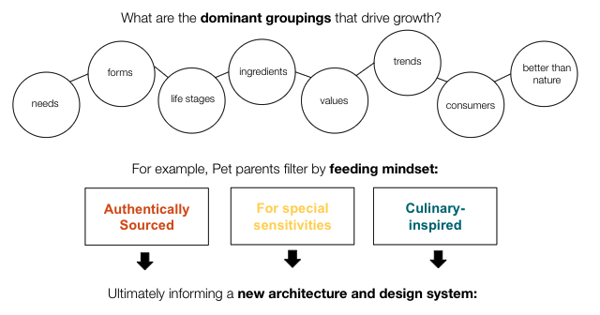Written by
Melissa Lohrer
In the excitement of launching new product lines, celebrating your top-performing SKUs, or looking for opportunities to reach new audiences, it can be easy to lose sight of the bigger picture. Architecture is the tool that helps brands see the forest for the trees.
It’s not just a theoretical exercise. With an eye on real-world implications, brand architecture will give you the reins to guide the consumer experience, reveal opportunity for innovation, and strengthen brand equity.
There’s no way to know with complete certainty what the future holds for your brand. But when the opportunity arrives to set yourself up to respond with clarity and intention, it’s best to grab it.
A blueprint for growth
We like to think of brand architecture as a blueprint. It defines the role and interrelationships between the master brand and sub-brands or pillars, and guides consumers into navigating your brand the way you intended.
“Architecture is really about leveraging all the right tools to determine how you want consumers to navigate. What are the little levers you can pull?” says our co-founder, Catherine Clark.
Like most elements of your brand, architecture isn’t something you can set and forget. Often brands establish an architecture that works…until it doesn’t. As portfolios grow, consumer behavior shifts, and outside forces—like the rise of e-comm, new competitors, and the latest innovation—will lead brands to optimize and evolve their architecture over time. Starbucks has a successful, yet disparate, range of RTD beverages. Their role and benefits were somewhat ambiguous creating potential consumer confusion plus a need for clarity around future innovation. By understanding each sub-brand’s relationship to the masterbrand, its purpose and its level of ‘coffee-ness’ the portfolio was thoughtfully organized into need-based pillars identifying areas of global new product development. See how we helped architect the portfolio for clarity and future growth.
Starbucks has a successful, yet disparate, range of RTD beverages. Their role and benefits were somewhat ambiguous creating potential consumer confusion plus a need for clarity around future innovation. By understanding each sub-brand’s relationship to the masterbrand, its purpose and its level of ‘coffee-ness’ the portfolio was thoughtfully organized into need-based pillars identifying areas of global new product development. See how we helped architect the portfolio for clarity and future growth.
Understanding how consumers shop your category and what drives them in their decision-making is the starting point for defining effective architecture.
Future-proofing your brand
A brand without a clear, intuitive architecture leaves itself vulnerable to confusion. This kind of chaos can cause a lack of focus internally, poor performance at the point of purchase, and unfavorable perceptions from audiences. And it can happen suddenly: as categories continue to shift dramatically, it’s easy for a brand to be on-track one quarter and out-of-step the next.
Laying the foundation with brand architecture upfront creates a blueprint for conscious growth in the future, granting you at-the-ready answers to questions like:
- How are my products organized? (i.e. Benefit, Product Form, Ingredients…)
- What are the codes & cues that drive design principles across the portfolio?
- What pillar does my future innovation live within?
- Where is there white space for innovation?
Having clear insight on this gives you the tools to grow with purpose. As your brand evolves or the marketplace changes, brand architecture helps you strategize instead of rushing to find footing. We think of it as future-proofing: a way of working with what you have now to authentically respond to a future that’s yet to come.
“Brand architecture creates clear guardrails for future innovation and extension,” says our creative director, Adrienne Muken. It’s a framework through which to find a fit for new opportunities within your guiding principles, optimizing internal innovation.
Clarity from Chaos
Ultimately, architecture is about maximizing brand performance. A consumer-driven architecture starts with identifying the role your brand and its offerings plays in consumers lives.
When necessary, radically rationalizing products, simplifying pillars can enables intuitive shopping and maximize presence on shelf.
A pioneer in cold-pressed juice, Evolution Fresh had been forced to vie for space in its own category. In response, a decision to launch different product forms and sub-brands resulted in diluting the brand meaning, causing consumer confusion and a dramatically weakened performance. A shift from fragmented pillars to a monolithic model, in addition to a redesign of the visual system, led to double digit growth for the brand. See how architecture inspired a refreshed visual identity for Evolution Fresh.

And the benefits don’t stop at the end of that transaction. Building brand equity—and utilizing an architecture that allows you to maximize its value—can help broaden your relationship with consumers beyond one product.
As you map how to engage more customers across the portfolio, the purpose of each offering has the opportunity to become more nuanced. Different offerings can have different roles - from sustaining the business, to driving growth, or keeping things fresh.
This kind of lucidity is a superpower for unlocking efficiency all around: more effective consumer targeting, and ultimately, more impact per marketing dollar.
In action
Successfully creating and implementing brand architecture can get heady at times, so having a game plan is crucial. We organize the process around four steps:
1. Define Your Swim Lanes
What are your dominant portfolio groupings that will drive growth? Consumer needs and trends should factor into this decision - but so, too, should your brand's specific values, and the purpose of your offerings up until this point.

2. Consider the Portfolio Today and Tomorrow
How can it best be organized around swim lanes? This step should take into account consumers, customers, and retail context, as well as growth plans. This doesn't apply to just CPG brands- tech brands can see it in play in Harman's experiential bundles architected around pain points and solutions.
3. Establish Architecture
How does the master brand relate to sub-brands? What is the perceived equity of the master brand, and how is it relevant to sub-brands?
Re-envisioned architecture for Nutro connects the brand's food philosophy and its products with people’s food beliefs, inspiring a distinct visual language.
4. Explore Design
How will the architecture come to life visually? This is the time for design tests, to evaluate visual codes and cues, and to create a design system that factors in how each sub-brand and line relates to the master brand.
The stakes are high for brand architecture, and its impacts are far-reaching. Sales, innovation, insights, and senior leadership should all be at the table—and so should a partner who comprehends the strategy as well as the real-life manifestation.
We execute brand architecture with a mindset of integration. Instead of a strategist passing off a torch to a designer, we work together from the beginning to create architecture that works not just in theory but on the shelf (or e-comm site) and among your internal teams.
Want to chat more about brand architecture?

Sign up for the latest news and views
